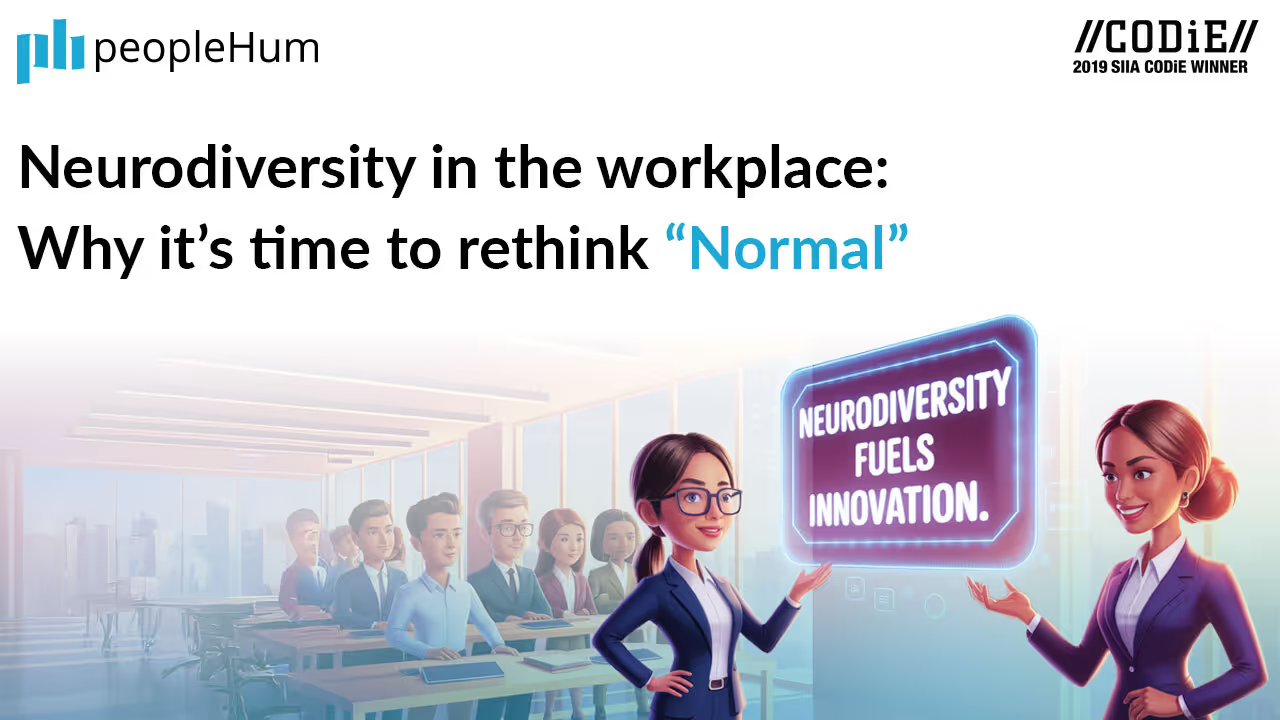The missed potential sitting in plain sight
Imagine this.
You’re hiring for a data analyst. The resumes look great. One stands out obsessive attention to detail, self-taught Python pro, completed side projects that even your seasoned team would admire. But the interview? They avoid eye contact. Their speech is flat. There's an awkward pause after every question. Someone on the panel scribbles, “Not a culture fit.”
That candidate? Could’ve been your next big innovator. But you filtered them out because they didn’t “vibe.”
Welcome to the reality of most hiring pipelines. Neurodiverse talent people whose brains work differently, is being excluded not because of lack of skill, but because our systems are designed around what feels familiar, not what’s truly effective.
What is neurodiversity, really?
Neurodiversity is the idea that neurological differences like autism, ADHD, dyslexia, and dyspraxia are natural variations in how human brains function. They’re not disorders to be fixed, but perspectives to be understood.
We’re talking about:
- Autism Spectrum Disorder (ASD): Often strong in pattern recognition and logical thinking
- ADHD: High energy, rapid ideation, creative bursts
- Dyslexia: Difficulties with reading but often exceptional spatial reasoning
- Dyspraxia: Motor coordination challenges, yet great abstract thinkers
This shift from “deficit” to “difference” isn’t just semantic. It’s foundational. Because once you see these traits as advantages, not flaws, you redesign everything—from how you hire to how you lead.
Is the workplace built for cognitive sameness?
Let’s be honest. Most job descriptions still say things like “must be a great communicator” or “team player with excellent interpersonal skills.” Sounds harmless, right?
But for someone with social anxiety or who prefers written communication, those phrases say: “This job isn’t for you.”
The irony? Neurodiverse employees often:
- Stick longer with companies when supported
- Outperform peers in areas like data analysis, coding, and product testing
- Bring unique problem-solving approaches to stagnant teams
A 2023 Harvard Business Review study found that neurodiverse teams at SAP were 30% more productive and generated better innovation outcomes than their neurotypical peers.
The workplace isn’t broken, it’s just not built for everyone yet.
Region focus: What do the numbers say?
Let’s zoom in on the UK, where government-backed inclusion efforts have given us some of the most robust neurodiversity data.
- Over 15% of people in the UK are neurodivergent (ONS, 2022)
- Only 22% of autistic adults are in any kind of paid employment (National Autistic Society, 2021)
- More than 50% of employers admit they wouldn’t feel confident hiring someone neurodiverse without support
In the US, the CDC estimates 1 in 36 children are diagnosed with autism, and these children are now entering the workforce. Yet corporate hiring models haven’t adapted to support them.
These stats don’t point to a talent shortage. They point to an inclusion gap.
Why should businesses pay attention now?
The world of work is changing. Customers are demanding ethical, inclusive brands. Investors are using ESG metrics to evaluate company value. And innovation? It’s no longer a nice-to-have. It’s a survival skill.
Companies that embrace neurodiversity can expect:
- A reduction in groupthink
- A surge in creative problem-solving
- Teams that reflect the world we actually live in
Inclusion isn’t about ticking a box. It’s about tapping into cognitive horsepower your competitors aren’t even seeing.
What keeps companies from hiring neurodiverse talent?
It’s rarely about bad intentions. Most of the time, exclusion happens not because someone actively chooses to discriminate, but because the system was never built with neurodiverse individuals in mind. Hiring processes often prioritize speed, confidence, and verbal communication, which can unintentionally screen out brilliant candidates who simply express themselves differently. Many managers don’t even realize that their go-to interview questions or expectations are making it harder for neurodiverse applicants to shine. Add to that a lack of training, limited awareness, and fear of doing or saying the wrong thing, and the result is passive exclusion. It’s not malicious it’s structural. And the good news? Structures can be redesigned.
Barriers include:
- Over-reliance on verbal interviews that disadvantage candidates with communication differences
- Unconscious bias from hiring managers equating “like me” with “qualified”
- Lack of awareness about what neurodiversity is and how to support it
- Fear of doing the wrong thing, leading to doing nothing at all
What’s needed isn’t just policy change. It’s a mindset shift from culture fit to culture add.
What does a neurodiverse-friendly hiring process actually look like?
You don’t need to change everything at once. Start by tweaking the parts of your hiring process that matter most like how you write job descriptions or how interviews are structured. Small adjustments can make a big difference in helping neurodiverse candidates feel seen and supported. It’s about progress, not perfection. Even one thoughtful change can open the door to exceptional talent.
Here’s what works:
- Rewrite job descriptions to focus on outcomes, not personality traits
- Replace verbal interviews with job simulations or take-home tasks
- Provide interview questions ahead of time
- Let candidates choose written, video, or in-person interviews
- Publicly share your willingness to provide accommodations
When neurodiverse candidates see that you’ve built the door wide enough for them to enter, they’ll walk in—and bring brilliance with them.
What support systems help neurodiverse employees thrive?
Hiring is just the beginning. To truly support neurodiverse employees, your workplace needs the right infrastructure. That means building environments where flexibility is encouraged, communication is clear, and trust is part of the culture. When neurodiverse individuals feel supported and understood, their productivity and creativity soar. It's not about offering special treatment, but about creating conditions where everyone can do their best work.
Key support systems include:
- Quiet zones or noise-cancelling options for sensory sensitivity
- Clear instructions with visual aids or checklists
- Managers trained on neurodiversity and inclusive leadership
- Peer mentorship and buddy systems
- Tech tools like screen readers, mind-mapping software, or scheduling aids
What seems like a minor tweak to one employee might be the thing that unlocks productivity for another. Inclusion scales, one adjustment at a time.
How can HR measure success in neurodiversity efforts?
If you don’t track it, you can’t improve it. That’s true for any business goal and inclusion is no exception. Without data, you’re just guessing what’s working and what’s not. Tracking neurodiversity metrics like hiring rates, retention, employee feedback, and performance outcomes helps you understand the real impact of your efforts. It also shows your team and leadership that inclusion is more than a value it’s a measurable priority.
Metrics to consider:
- Number of neurodiverse candidates applying and being hired
- Retention and promotion rates for neurodiverse employees
- Anonymous employee feedback on inclusion and accessibility
- Performance outcomes of neurodiverse teams
- Participation in neurodiversity-focused ERGs or programs
Data gives HR leaders a clear picture of what’s working—and where to invest next. Start simple. Measure what matters.
What can HR teams do today to start supporting neurodiversity?
Waiting for perfect is the enemy of progress. You can start today with small, actionable steps.
Try this:
- Audit your job postings for exclusionary language
- Create a neurodiversity guide for hiring managers
- Partner with organizations like The Neurodiversity Hub or JAN
- Host a neurodiversity awareness session during your next DEI training
- Invite neurodiverse employees to co-create policies that affect them
Neuroinclusion isn’t a side project. It’s a leadership decision. The more intentional your actions, the more impact you’ll create.
The real question isn’t “why?”—it’s “why not now?”
Neurodiverse talent isn’t hard to find. It’s waiting behind outdated systems, untrained interviewers, and unspoken stigma. HR leaders are uniquely placed to change this.
The future of work isn’t uniform. It’s textured. Complex. Beautifully varied. That’s what makes it innovative. That’s what makes it human.
And for the companies bold enough to reimagine “normal,” the rewards aren’t just cultural. They’re commercial.



































.avif)












